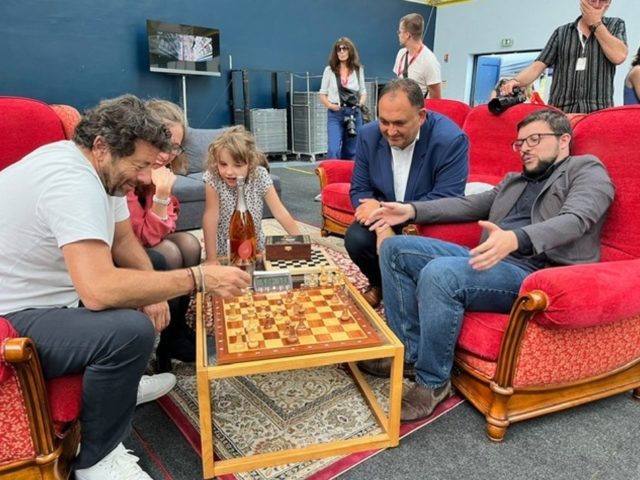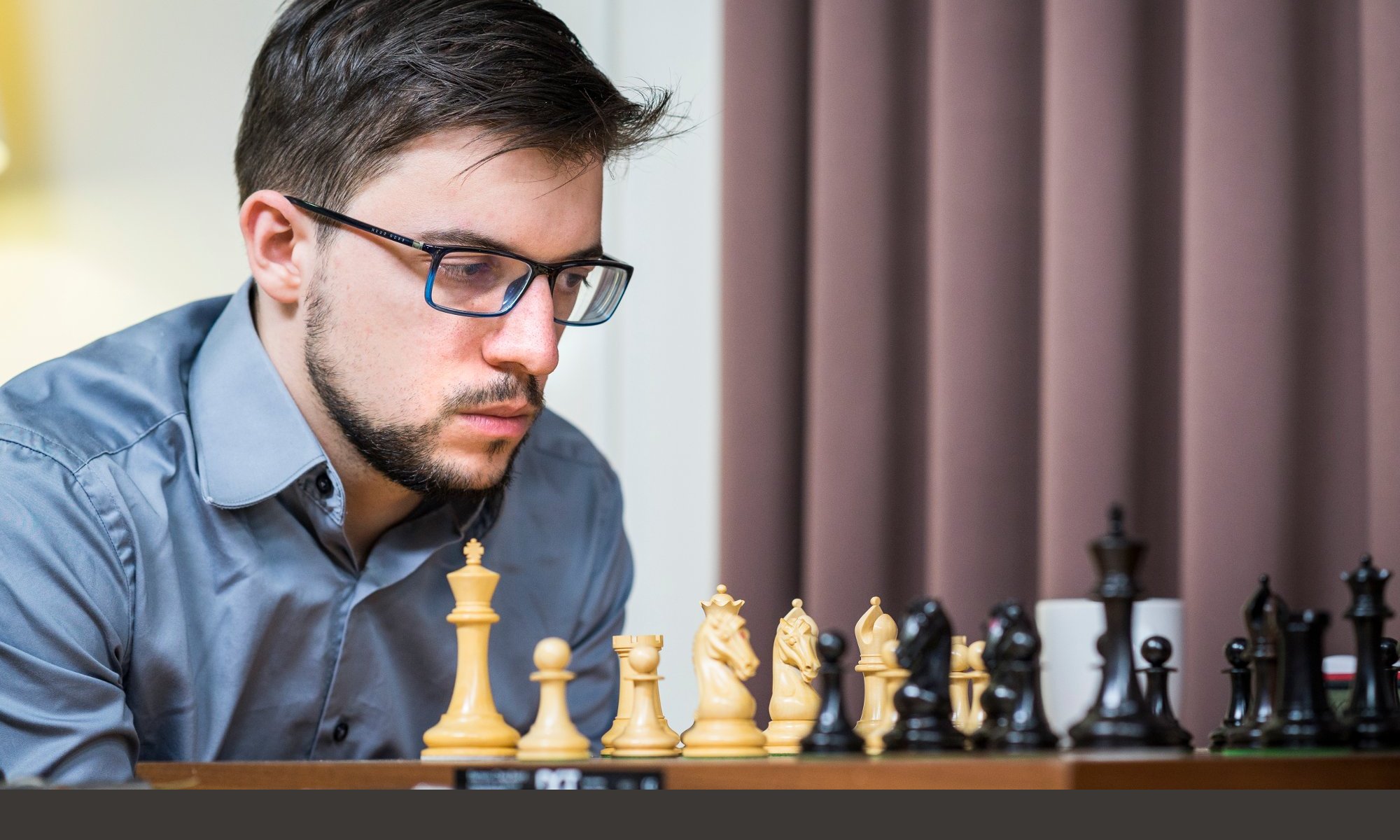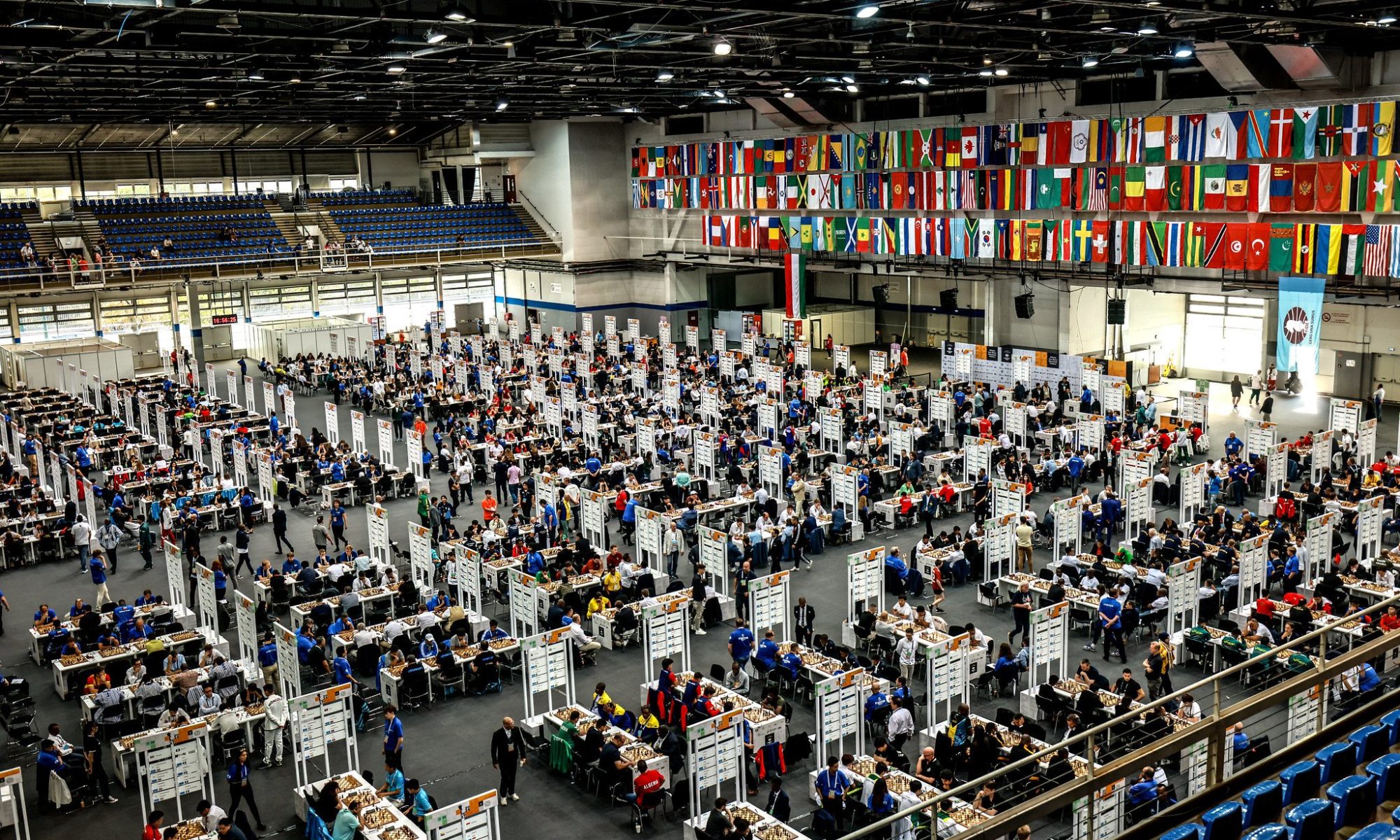Although I had relatively little rest on my return from the US tour, I was delighted at the prospect of being back with the French team and my team-mates, especially as I’d missed out on the 2022 Olympiad in Chennai (India). It’s a pity Alireza wasn’t there, because we could have lined up a great team against the armadas that were announced…
After a few unavoidable adventures during the team’s journey and installation, we quickly settled into Budapest, with our HQ in a restaurant at lunchtime, and a general routine before and after matches.
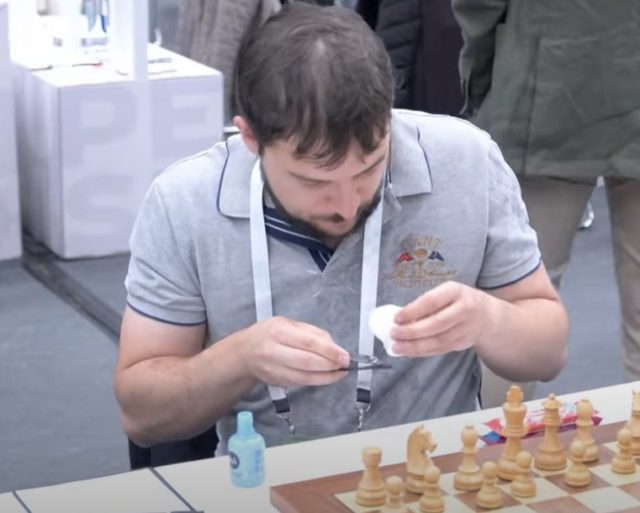
As early as my second game (Round 3 against Kadric, Montenegro), I had a problem with my glasses which really upset me. I found them with a broken temple in the morning (don’t ask me why!). The team captain, Sébastien Mazé, and I decided to have them repaired and set off on a tour of opticians in the Hungarian capital. Of course, I would have preferred to prepare for my game, but I can’t possibly function in everyday life without glasses 😊. Unfortunately, all the professionals we visited told us they would need at least 4 days. The problem was, I did have a spare pair, but they were sunglasses! (Spoiler, the Fide rules forbid wearing them during games). So we got smart and tried to fix them ourselves, using super glue. Ah, sure, this glue is super effective, but unfortunately not enough to glue the arm back, but enough to stain the glass! Which only made things worse, as so often in these cases. So my solution throughout the tournament was to keep the glasses without temples straight during the games, and to wear the sunglasses the rest of the time. Even when it was raining or dark in Budapest, you could spot a funny-looking guy in sunglasses 😊.
Admittedly, I got used to it, and during the games, it didn’t bother me that much. It didn’t interfere with my field of vision, the lenses were well placed, and the natural position of the glasses remained more or less stable. I just needed to readjust them regularly, and be a little careful that they didn’t fall off.

After this optical interlude, let’s get back to chess! As far as the team is concerned, while I quickly drew my game on the « glasses day », we lost that match against Montenegro. But we were back on track afterwards, and ended up in ambush before the rest day. We followed up in Round 7 against Georgia, a tricky match against players who aren’t highly ranked, but who are quite experienced; admittedly, it’s a rather aging team, despite the contribution of a new kid on the block (Kacharava), but who wasn’t playing against us.
I played a nice game, but we were still held to a 2-2 draw.
Mvl – Mchedlishvili (2574) 1-0
I had spotted that after 1.c4, the Georgian player had varied a lot during the tournament, and that he looked rather indecisive. During the rest day, I decided to take a closer look, especially after seeing that he sometimes played a Slav variation that he didn’t seem to know much about. What’s more, I’d already tried this line with black in the 2020-2021 online tournaments. I’d worked on it quite a bit and knew it was dangerous, especially after the pawn sacrifice in the following position:
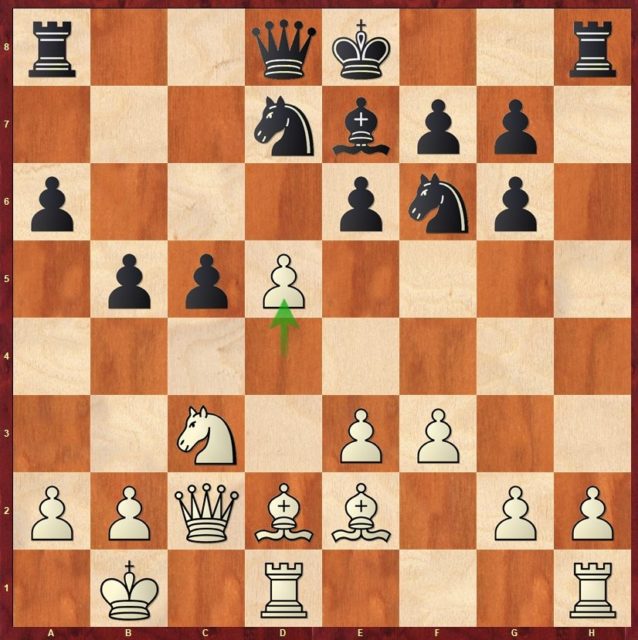
Despite this good basis, I messed up a bit because I remembered 15…Nxd5 as the main move, and if 15…exd5 I had 16.Bc1 Qb6! in my memory. So I knew that 16…Nb6?!
was no good, but I didn’t know why! After 17.g4 b4, I didn’t think at all about 18.Na4! a very difficult move that was the real refutation. Indeed, after 18.Nxd5 Nfxd5 19.e4 Nc3+ 20.bxc3 Qc8, I played 21.cxb4? a little out of spite because I felt I hadn’t optimized. I had envisaged 21.h4, which was the move to take the advantage by dissuading black from castling, but I didn’t believe in it. As the game progressed, while he had compensation for the two sacrificed pawns, he let me gradually consolidate my position.
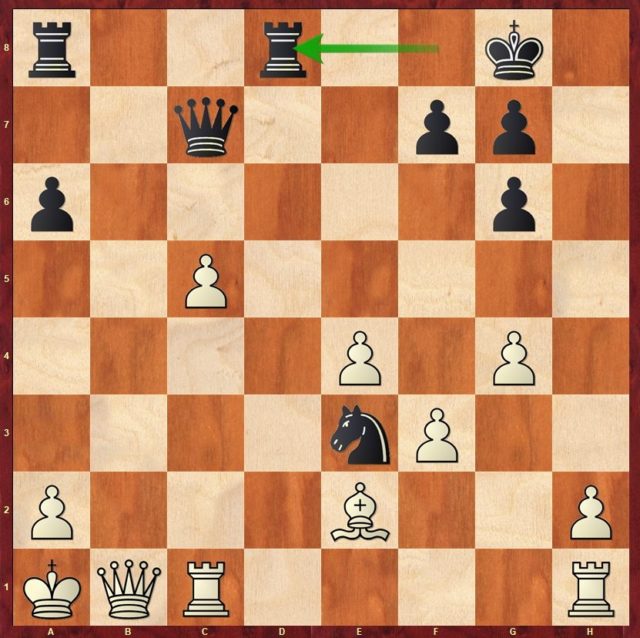
From then on, I played very well. There was some semblance of an attack for Black, but not enough… 28.Qb3! (on its way to c3, from where the Queen will control just about everything) 28…Qf4 29.Qc3 Rac8 30.Bd1! Rc7 31.Bb3 (a rather neat Bishop maneuver; the Fb3 is ideally placed for defense, but it also leans towards f7, which will pay off later) 31…Rdc8 32.Qd4! Qxf3 33.Rhe1 and of course I’ve returned the pawns, but my pieces are now ideally coordinated to conclude.
Unfortunately, we didn’t win the match, even though it was completely under control. So we were punished straight away as we were paired against the USA and its five players at 2700+ in the next round, whereas if we had won, we’d have been playing Hungary…
For my part, I’ve already played the 4 main members of the US team at least twenty times each, if not many more for some because Levon (Aronian) and Fabiano (Caruana), I think (counting all the cadences), it would be more between 150 and 200 times!
Caruana (2798) – Mvl 1/2
On the first board, I was black against Fabiano, and we quickly arrived at the next position, which came from the 3.Bb5+ variation against the Sicilian.
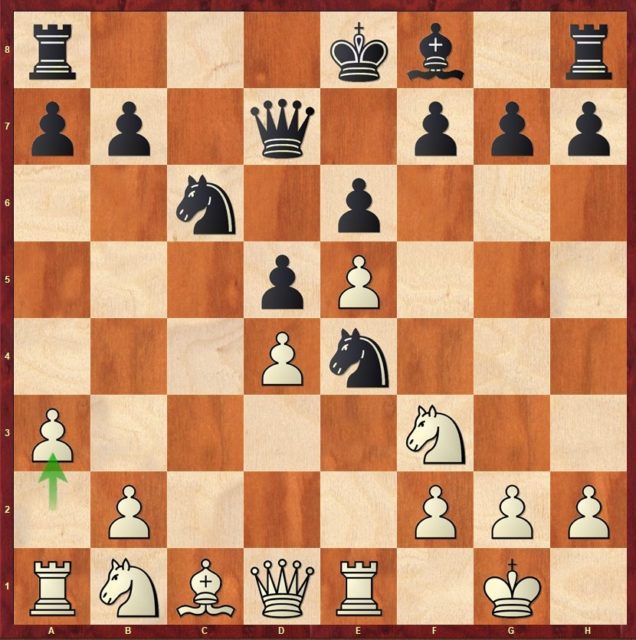
I had looked at this 11.a3 move a long time ago, probably more than 3 years. But during the training camp with the French team in Vichy, just before the Olympiad, we had discussed this idea for a few minutes, though I couldn’t remember the details ; so I improvised
😊. What’s more, in the match strategy, as we’d decided that Etienne (Bacrot) would play hyper solid chess with white against Wesley (So), the idea was obviously that for me, a draw would be a very good result with black; but that nevertheless, if I could avoid neutralizing everything and keep a few options open, it wouldn’t be any worse.
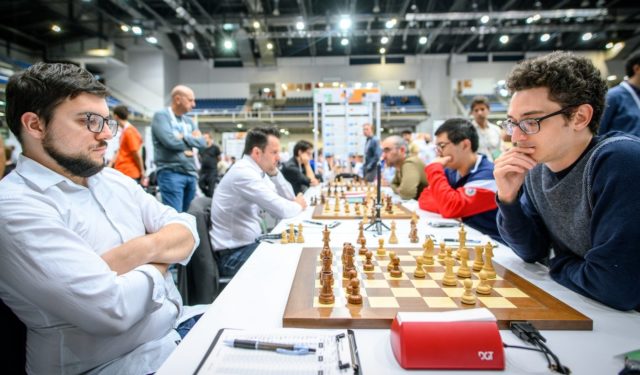
So I played with that in mind, trying not to find myself slightly worse, defending a position with no perspective, but rather keeping a few opportunities for counterplay.
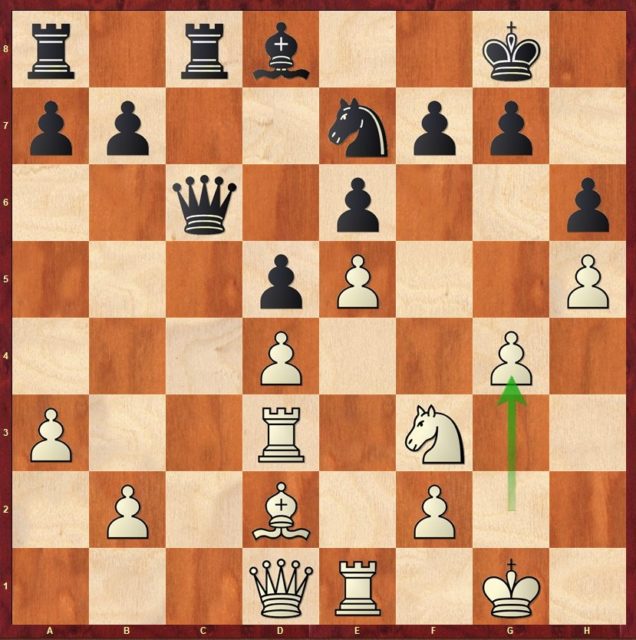
A critical moment because here Fabiano let me play 19…Qc2,calculating that he could take advantage of the trapped Rook on c2, but that wasn’t the case! After 20.Qxc2 Rxc2 21.Bc3 Nc6, he played 22.Red1. His basic idea was 22.Rb1, but there’s 22…Re2! (the computer says 22…Bg5 is ok too, but that leaves 23.Rdd1, or even 23.Nxg5 hxg5 24.Bd2, which, by the way, I thought he would play) 23.Nd2 (to play 25.Kf1; if 23.Kf1 at once, then 23…Re4 24.Nh2 f6, my Rook lands on f4, and even if it’s a bit acrobatic, it’ll come out!) 23…Bh4 and if 24.Rf3? Nxd4.
With the Rook on d1, I played 22…Bg5 since 22…Re2? no longer works due to 23.Nd2 Bh4 24.Nf3 and taking on d4 is no longer possible, the Cd2 being protected.
After 23.Ne1 Rc1 24.Rxc1 Fxc1, despite its apparent symmetry, this endgame isn’t completely straightforward because black is still short of space and, if white manages to play f4-f5, it can quickly become complicated on the Kingside. However, I managed this situation quite well and even got a few small chances around move 40 when he was running out of time; but he defended very well and everything simplified towards the draw.
In the end, we lost the match because Maxime (Lagarde) blundered in a rather promising position against Levon, and our opponents secured the rest of the match.
Against Italy, I played an insipid game and was totally neutralized by Vocaturo with white, but we ended up winning a match that had started quite badly. After that, we got things under control against England (I won against Vitiugov), and we went into the final round against the young reigning champions from Uzbekistan, with at least a fifth place at stake.
Unfortunately, we ended up losing this match, though we had a great opportunity because once again it was Maxime (Lagarde), in time trouble, who lost a very promising position. We can also regret Étienne’s draw, more or less without playing with white against Yakubboev, because while against So, we had collectively agreed that it was the right strategic choice, there, for a last round, we would have preferred him to play…
As for me, I was black against Abdusattorov, and it was a morning game where, out of necessity, the revisions are less thorough.
Abdussatorov (2766) – Mvl 1/2
Here’s the position we got after 20 moves of a very complex Najdorf.
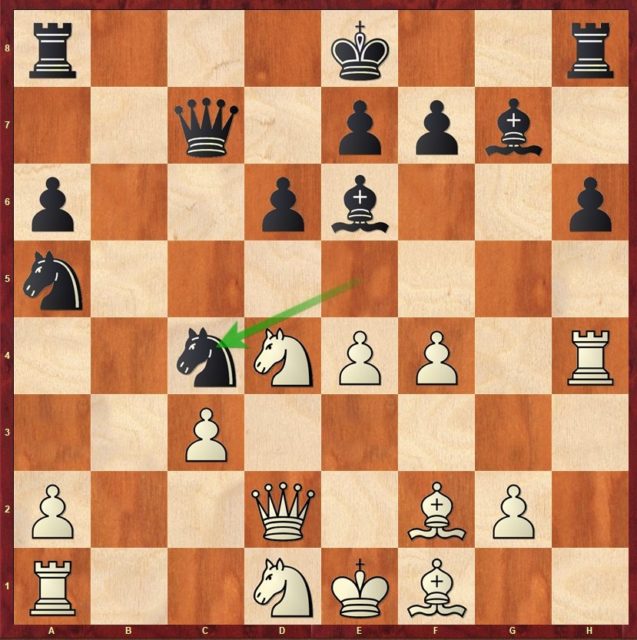
For the record, Vladimir Kramnik, who was the captain of the Uzbekistan team, said to me right after the game, with his legendary optimism 😊: « but you were completely lost had Nordibek played this… ». On the spot, I thought he was telling me that I was completely winning, because later in the game, it did look more promising for me. But even so, I didn’t understand where I would have been winning either! I finally understood he was referring to the diagrammed position, arguing that if white had played 21.Nxe6 fxe6 22.Qd3 (instead of 21.Qd3 right away, allowing 21…Bd7!) « [Nordibek’s position] would have been winning ».
He’s not entirely wrong, in the sense that I’m actually worse in this variation, but certainly far from losing! It’s a tricky position to be in, but it doesn’t look that bad and, above all, it leaves plenty of play for both sides.
In the end, I managed the rest of the game rather well, and got quite a bit of play afrer sacrificing a pawn ; but it wasn’t enough to win.
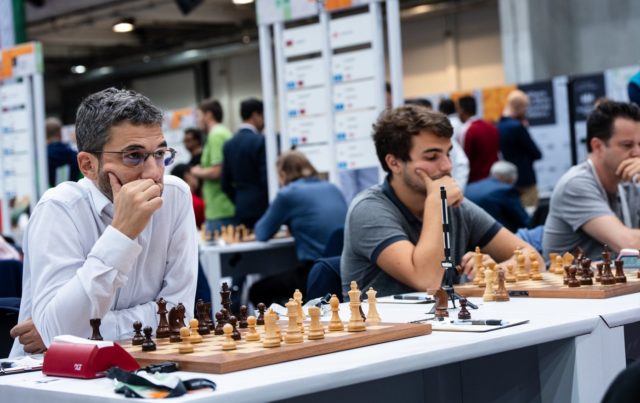
In terms of final results, the Olympiad was rather disappointing, as we finished in 15th place. As we didn’t have one of the best line-ups, everyone would have had to outperform to keep any hope of a podium. But it’s clear that no-one in the French team was in exceptional form. There were certainly some good things. Laurent (Fressinet) at the end, Marc’Andria (Maurizzi) over a large part of the tournament (apart from his defeat against England, which was a bit damaging); for his part, Maxime (Lagarde) set the tournament alight, even if it backfired in the two matches we lost at the end. But in other circumstances, it could have been a very good tournament, and in any case, he’s in the right frame of mind.
On a personal level, 7/10 is good, but not prodigious either. In fact, it’s a result that suffers from comparison with other first board players, such as Gukesh or Abdusattorov, who achieved stratospheric performances in Budapest!
Incidentally, I’d like to take this opportunity to salute the Indians’ double gold medal, which really is beyond dispute…
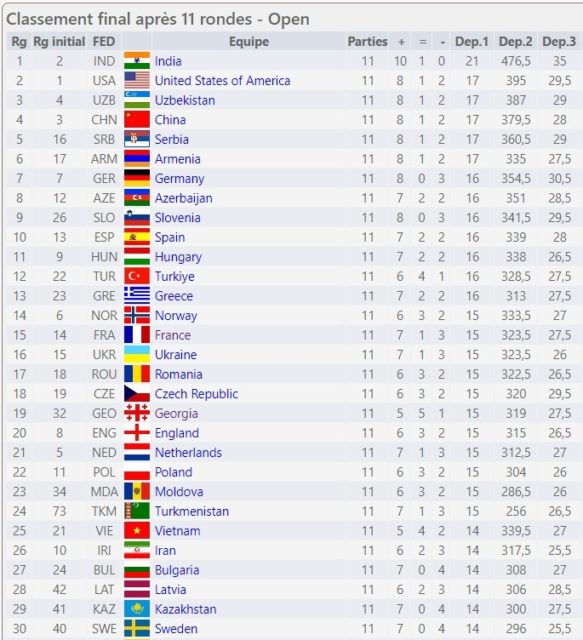
Champions Chess Tour
Three days after returning from Budapest, I took part in the final tournament of the Champions Chess Tour, in Division 1. Having already qualified as one of the Top 8 players on the circuit who will compete in the face-to-face finals in Oslo from December 17 to 21, my main concern was to play good chess, at a rhythm of play I like (10+2). The result was mixed, as I won my matches against Nepo and Grischuk, but lost twice to Aronian, finishing in fourth place in the final rankings. But what I’ll remember most is that this is the second tournament in a row on this circuit where I’ve been awarded the beauty prize! This time, for my mating attack against Nepo…
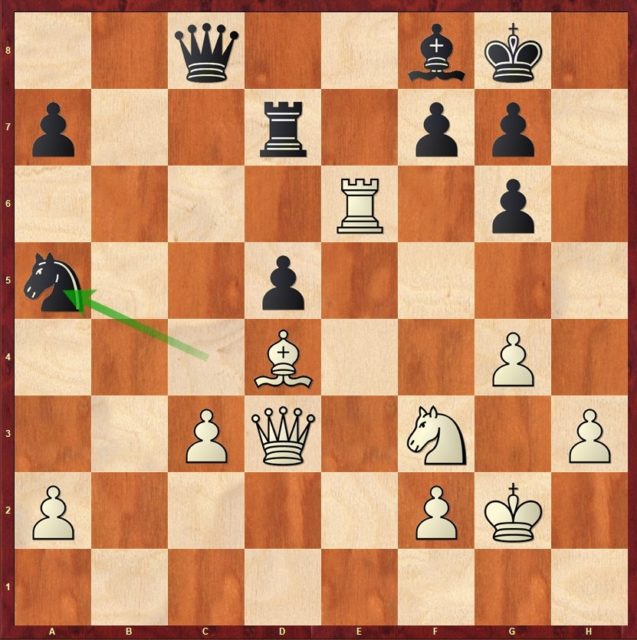
Here, my Rook is under attack, but a retreat move like 29.Re2 would leave white with almost no advantage. I spent quite a bit of time (2 minutes) on 29.Ng5! because, even though it’s a fairly obvious move, I wanted to check that I hadn’t forgotten any defense. Of course, if 29…fxe6 30.Qxg6 wins instantly. If 29…Be7, the answer is easy, 30.Nxf7. I had also calculated 29…Re7 30.Qg3, although in that one you’d still have to find the punishment for 30…f6, namely 31.Bxf6! gxf6 32.Rxf6 and if white’s attack isn’t instantly winning, it’ll still be devastating. That leaves 29…Rd6. I’d planned 30.Qf3 as the simplest answer ; he still can’t take on e6, and if 30…Qd7, I’ve got 31.Rxd6 Bxd6 32.Qxd5. As for 30…Qxe6, it leaves black no chance of fortress at all. But since I also saw 30.Qg3, I didn’t hesitate to calculate it! If 30…fxe6 31.Qh4 is mate. Ditto after 30…Qxe6 31.Qh4. So it wasn’t so hard to understand that after 30…Qd8, 31.Re8! was so strong. It looks spectacular, but honestly, it’s extremely easy…31…Qxe8 32.Qh4 Qe4+ and now,33.Kg3!, the icing on the cake! I could have played 33.Kg1 or even 31.f3, but I chose the more aesthetic; I use the fact that the Rd6 blocks the Bishop’s check on d6!
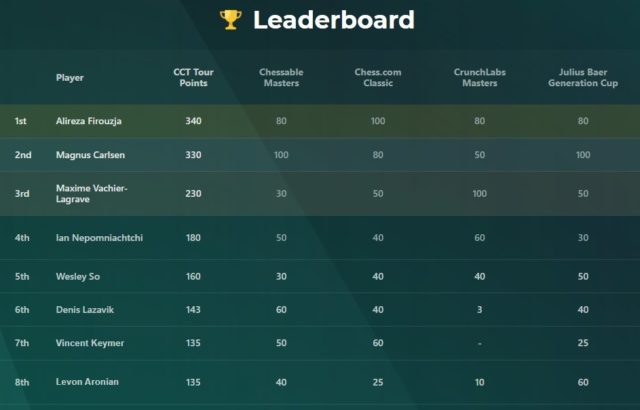
As an anecdote, while I was playing, I thought of my 2011 game against Wang Hao (in Wijk aan zee), not at all featuring this opening but where I had this same attacking theme.
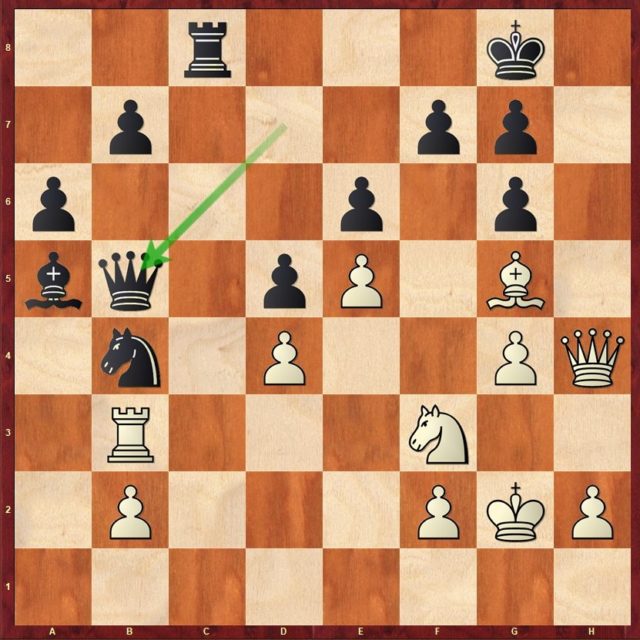
In this completely winning position, I’m spoilt for choice. 32.Nd2 followed by 33.Rh3 does the job, as does the aesthetic 32.Bf6, followed by 33.Ng5. But I chose 32.Be7? thinking that the threat of 33.Ng5 would force resignation, since if 32…Nd3 33.Rxd3 (33.Ng5?? Nf4+ 35.Kg3 Qxb3+ and if 36.Kxf4? Bd2#); but now black has a defense arising from nowhere, 33…g5!! and if 34.Nxg5? Qxd3 controls h7. Miraculously, white would still stay alive with 34.Rc3! gxh4 35.Rxc8+ Kh7 36.Bxh4, but in the game, I preferred to absorb the shock with 33.Rxb5 Nf4+ 34.Kg3 (34.Rh1 Rc1+ 35.Ng1 Ne2 would have been playing with fire!) 34…Ne2+ 35.Kh3 Nf4+ and perpetual.
My next stop is London. I’ll be taking part in two tournaments in a row: the Global Chess League from October 3 to 12, a team tournament with 20′ games and no increment! Then the WR Masters from October 14, which will feature a new and original formula. A bracket of 16 players with a KO system, and the fastest rate of play to be homologated as classic (1h/30, 30’/20 + 30′ ko). The icing on the cake is that both games of a match will take place on the same day, with a possible Armaggedon tie-break in the evening! A particularly busy program awaits us 😊.
Budapest’s games:
Champions Chess Tour games:
Maxime’s game against Wang Hao:
Every year in early September, the huge « Foire de Châlons-en-Champagne » is the place to be. A must-see for the country’s leading political figures, it’s also a place for conviviality and festivities, with concerts every evening. The closing concert on Sunday September 8 featured Patrick Bruel, one of France’s best-known singers and actors. L’Echiquier Chalonnais, which is very active in the Grand Est region and headed by former French Federation President Diego Salazar, invited the singer, as a good chess fan, to play a friendly game against Maxime. A similar initiative took place with Garry Kasparov in 2013. The game took place backstage just before the concert. Despite the help of French GM Marie Sebag, Patrick Bruel bowed out with a smile, before heading off to perform in front of the 18,000 or so spectators who were waiting for him!
